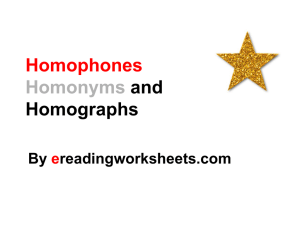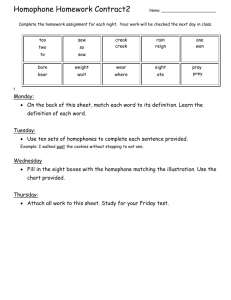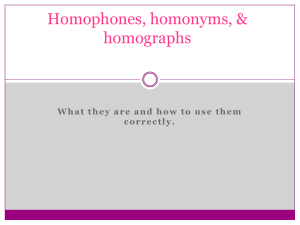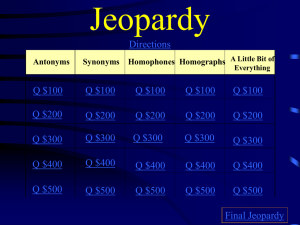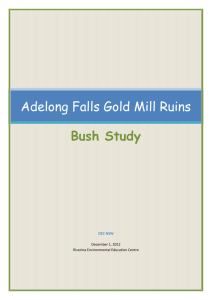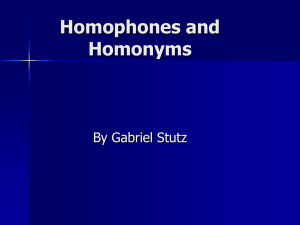Building Vocabulary
advertisement
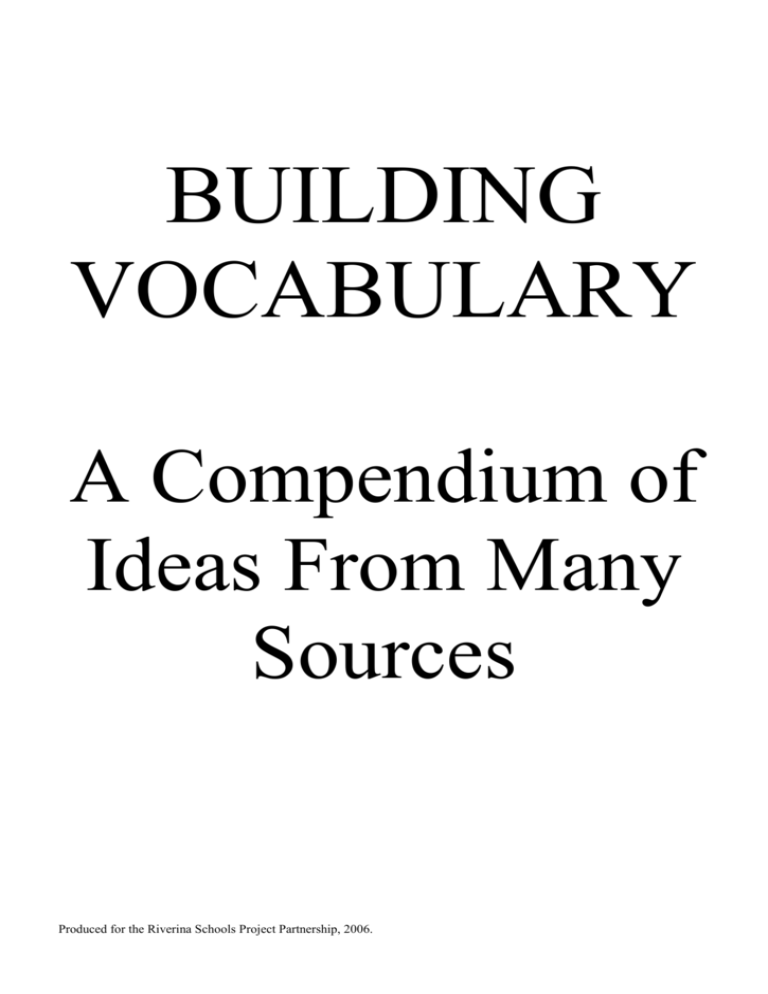
BUILDING VOCABULARY A Compendium of Ideas From Many Sources Produced for the Riverina Schools Project Partnership, 2006. Table of Contents Lesson 1: Root Words 1. Animal Drawing Cards 2. Crossword 3. Matching, Memory, Fish Lesson 2: Word Concept Mapping 1. Word Concept Definition Mapping 2. ABC Word/ Concept Map 3. Don’t Double Up 4. Word Association 5. Word Meaning Checklist Lesson 3: Synonyms and Homonyms 1. Roundabout 2. Synonym Partners 3. Synonym Password 4. What’s In The Bag 5. What I Didn’t Do On The Weekend Lesson 4: Homophones and Homonyms 1. Homophone (Homonym) Memory 2. Homophone (Homonym) Snap 3. Homonym Quiz 4. Homonym Crossword 5. Homophone Quiz 6. Homophone Worksheet 7. Homophone and Homonym Stories Produced for the Riverina Schools Project Partnership, 2006. LESSON 1: ROOT WORDS1 Introduction The words in the English language were not just made up by throwing sounds together. Most of the words in the English language were borrowed from other languages, in particular German, French and Latin. However, it is important to note that not all words were borrowed. There are numerous words have developed as an extension of a root word from the English language. A root word is a word that has nothing added at the beginning or the end of it. A root word stands on its own as a word, and has meaning. New words can be made from root words by adding beginnings (prefixes) and endings (suffixes). For example: Derma- means ‘skin’. A prefix or a suffix can be added to this to make a complete word such as ‘epidermis’ or ‘dermatitis’. Script- means ‘writing’. A prefix or a suffix can be added to this to make a complete word such as prescription; scripture Employ- means ‘to utilise’. A prefix or a suffix can be added to this to make a complete word such as employment, unemployment, employer, employee, employing Beauty- means ‘attractive’ A suffix can be added to this to make a complete word such as beautiful, beautifully, beautician These words have grown from their root word. They share parts of the same spelling and they are linked in terms of meaning. Aim To increase a student’s awareness that a word can be broken down into different parts (prefix + root + suffix). The root word gives a clue as to the meaning of the word. The aim is for the students to recognise the root word within an extended word to identify meaning and consequently increase vocabulary. British Broadcasting Centre (2006) ‘Skillwise Factsheet’. Viewed 21st August, 2006, from http://www.bbc.co.uk/ skillswise/words/spelling/wordbuilding/rootwords/factsheet.shtml 1 Other names that can be used for root word: stem word, base word. Produced for the Riverina Schools Project Partnership, 2006. Drawing activity Materials Root word cards Blank paper Pencils Method 1. Hand out the root word cards to each child and instruct them to underline the root word they see in the nonsensical word. Choose the level of difficulty - easy, medium or hard. 2. Instruct the class to draw what they think the nonsensical animal or thing should look like, remembering to place focus on the root word in their picture. Give the student a few minutes to do so. 3. When everyone has finished drawing their picture, ask 5 students to present their picture to the class. Get the remaining students to guess what the nonsensical word was. Produced for the Riverina Schools Project Partnership, 2006. Drawing activity (EASY) Origin Meaning Example _________________________________________________________________________________ Bi Two _________________________________________________________________________________ Tri Three _________________________________________________________________________________ Milli Thousand 1000 __________________________________________________________________________________ Centi Hundred __________________________________________________________________________________ Deca Ten 10 ___________________________________________________________________________________ Semi Half Produced for the Riverina Schools Project Partnership, 2006. Drawing activity (MEDIUM) Origin Meaning Example _________________________________________________________________________________ Bi Two _________________________________________________________________________________ Tri Three _________________________________________________________________________________ Super Above _______________ _________________________________________________________________________________ Astro Star __________________________________________________________________________________ Tele Far ___________________________________________________________________________________ Poly Many ___________________________________________________________________________________ Micro Little Produced for the Riverina Schools Project Partnership, 2006. Drawing activity (HARD) Origin Meaning Example ____________________________________________________________________________ Mania Crazy ____________________________________________________________________________ Poly Many _____________________________________________________________________________ Ortho Straight ______________________________________________________________________________ Cycle Repeated pattern ______________________________________________________________________________ Micro Little ______________________________________________________________________________ Pre Before ______________________________________________________________________________ Post After ______________________________________________________________________________ Produced for the Riverina Schools Project Partnership, 2006. WORD ROOT ANIMAL CARDS EASY Biheaded Cat Trilegged Boy Millitailed Pig Centieyed Fly Decatoothed Fish Semielephant Bitailed Leopard Triheaded Lion Millistriped Dragon Centispotted Frog Decacoloured Whale Semieyed Unicorn Produced for the Riverina Schools Project Partnership, 2006. WORD ROOT ANIMAL CARDS MEDIUM Catsuperwater Tritailed Dog Biheaded Dog Polycoloured fish Bimicro house Blueastro flag Tritrunked elephant Polyeyed girl Tricoloured Whale Astroeyed Unicorn Polystriped Monkey Microlegged Dog Produced for the Riverina Schools Project Partnership, 2006. WORD ROOT ANIMAL CARDS HARD Polylegged Fish Polyeyed Girl Orthostriped Monkey Monkeysubwater Microeared Mouse Microheaded Boy Maniac Cow Prebedtime Girl Postchristmas Morning Orthotailed Pig Microlegged Dog Polytoed Horse Produced for the Riverina Schools Project Partnership, 2006. ROOT WORD CROSSWORD (EASY) 1. 5. 6. 4. 2. 3. Clues This word means… Across 1. Ten 2. Two 3. Thousand 4. Three Down 5. Hundred 6. Half Please note: to make this activity easier provide students with reference sheet. Produced for the Riverina Schools Project Partnership, 2006. ROOT WORD CROSSWORD (MEDIUM) 3. 5. 1. 2. 4. 6. CLUES This word means… Across 1. Two 2. Above 3. Far 6. Small Down 3. Three 4. Many 5. Star Please note: to make this activity easier provide students with reference sheet. Produced for the Riverina Schools Project Partnership, 2006. ROOT WORD CROSSWORD (HARD) 1. 5. 4. 3. 2. CLUES This word means… Across 1. Crazy 2. After 3. Straight 4. Many Down 1. Small 2. Before 3. Repeated Pattern Please note: to make this activity easier provide students with reference sheet. Produced for the Riverina Schools Project Partnership, 2006. ROOT WORD CROSSWORD (EASY) (ANSWERS) 1. 5. D E C A 6. E S N E T M 4. 2. T R I M I B I L I 3. L Clues This word means… Across 1. Ten 2. Two 3. Thousand 4. Three Down 5. Hundred 6. Half Produced for the Riverina Schools Project Partnership, 2006. Please note: to make this activity easier provide students with reference sheet. ROOT WORD CROSSWORD (MEDIUM) (ANSWERS) 3. 5. T E L E A R S I T 1. B 2. 4. S U P O 6. M I C R O L Y CLUES This word means… Across 1. Far 2. Above 3. Far 6. Small Down 3. Three 4. Many 5. Star Produced for the Riverina Schools Project Partnership, 2006. E R O Please note: to make this activity easier provide students with reference sheet. ROOT WORD CROSSWORD (HARD) (ANSWERS) 1. M I A N I A 5. C 4. C P O R L Y C 3. O R T H O L E 2. P O S R E CLUES This word means… Across 1. Crazy 2. After 3. Straight 4. Many Down 1. Small 2. Before 5. Repeated Pattern Produced for the Riverina Schools Project Partnership, 2006. T Please note: to make this activity easier provide students with reference sheet. Root Word Matching, Memory, or Fish Materials Root word and Suffix cards (see below) Pencil and paper Method 1. Introduce the class to the concept of root words. 2. Provide each student with a set of cards, or one set per group. Instruct the students to match the root words with the appropriate suffix card. Some cards can go with more than one suffix. Eg. Bi-cycle and Tri-cycle. This matching of pairs could also be played as a game of Memory or Fish. Memory- Place all cards face down. Instruct the students to take turns turning over two cards. When a root word and a matching suffix are turned over, the child collects the cards as a matching pair. For example: Tri and cycle would be a pair. Fish- Each student picks up five cards from the face down pile. The aim is to collect pairs (root word + suffix). Each student takes a turn to ask the other players if they have a card that is the pair to one of their own cards. For example they might ask “Do you have a card that would be the suffix for Tri?”. Students need to recognise the possible suffixes that could match the root words. If a student has the requested suffix card, they give it to the asking student. If no-one has the requested suffix card the student needs to pick up a card off the pile of remaining cards. This game may be more suitable for older students. 3. Once the students have collected their word pairs they can write a list of other words using the root word. For example, they could write tricycle, triceratops, tripod etc. If the students have trouble thinking of more words using the root word they can use a dictionary to find more. Following the activity instruct the students to identify the meaning of the root word. For example, Tri means Three. 4. Randomly choose 5 students to present their list of words to the class. The class need to listen carefully to the words, and come up with any more, and guess the meaning of the root word. Produced for the Riverina Schools Project Partnership, 2006. tri cycle tri ceratops tri pod bi annual bi cycle cent ipede cent ury Produced for the Riverina Schools Project Partnership, 2006. cent imetre tele phone tele vision astro logy astro naut milli metre milli pede Produced for the Riverina Schools Project Partnership, 2006. Pairs Materials Root word and suffix/ prefix cards Root word reference sheet Method 1. Hand out a card and reference sheet to each student according to the level of difficulty. 2. Explain what each root word meaning on the reference sheet. 3. Get the students out of their seats and clear a space in the classroom. 4. Ask the students to walk around the class and find the person with their matching card. For example ‘Poly’ and ‘Many’ are a pair. 5. Following the activity instruct the students to share their pairs with the class. Produced for the Riverina Schools Project Partnership, 2006. Pairs (Easy) Bi Two Tri Three Milli Thousand Centi Hundred Deca Ten Semi Half Bi Two Tri Three Milli Thousand Centi Hundred Deca Ten Semi Half Bi Two Produced for the Riverina Schools Project Partnership, 2006. Pairs (Medium) Bi Two Tri Three Super Above Poly Many Micro Small Tele Far Astro Star Super Above Poly Many Micro Small Tele Far Astro Star Super Above Produced for the Riverina Schools Project Partnership, 2006. Pairs (Hard) Poly Many Ortho Straight Cycle Repeated pattern Micro Small Mania Crazy Pre Before Post After Poly Many Ortho Straight Cycle Repeated pattern Micro Small Mania Crazy Pre Before Produced for the Riverina Schools Project Partnership, 2006. WORD/CONCEPT MAPPING LESSON 2 Introduction When a student comes across a word/concept that they don’t understand during reading or conversation most children would look the word up in a dictionary in an attempt to give meaning to the word. However, looking up a definition of a word/concept is not as effective as analysing the word/concept2. An in-depth analysis of a word/concept can be done through a vocabulary building strategy known as concept mapping. What is a word/concept map? Word/Concept mapping is a strategy for teaching students the meaning of key concepts, independently. The word/concept map is a graphic organiser that allows student to3: Identify the word/concept that they are learning, Expand the word/concept meaning Identify a general category the word might be placed in, Identify its relationships to other words, Identify its essential attributes, qualities or characteristics of the word Develop examples of the word/concept, and Create extended definitions of the word/concept for themselves Aim To increase the student’s vocabulary by: Providing students with an independent and effective way to explore unknown concepts. Stimulating the students thinking outside the square (word). Teaching students to use a word/concept maps. To develop a student’s ability to recall associated words surrounding a concept, quickly. Anonymous. (no date). ‘Teaching and learning strategies’. Viewed 21st August, 2006, from http://www.sdb.k12.wi.us/curriculum/standards/state/SocialStudies/SS%20Chapters/SocStudies_14.pdf#search=%22%20%22Eggen%20an d%20Kauchak%201996%3A5%22%20filetype%3Apdf%22. 2 Adapted from Paynter, D., Bodrova, E., and Doty, J. (2005). ‘For the love of words: Vocabulary instruction that works’. Jossey-Bass, San Francisco, CA. 3 Produced for the Riverina Schools Project Partnership, 2006. Concept definition mapping Materials Concept map Blackboard/white board 1 black texta/ chalk Method 1. Draw a blank map on the board. Provide each student with a blank map of your choice. 2. Provide the students with a concept. Write this word in the centre of the map. 3. Ask students around the class to provide you with other words that are associated with the concept. 4. If the word doesn’t appear to be associated with the concept, ask the student to provide reasoning as to why the word it is associated with the topic/concept. 5. Write the words on the map. 6. Ask the students to copy them down. 7. Once all associated words have been exhausted, randomly choose 5 students to generate a definition of the concept. 8. Ask the students to write the definition down. 9. The students may like to get into groups with a new blank map and a dictionary to explore another concept by themselves. Produced for the Riverina Schools Project Partnership, 2006. Concept map Word Picture Produced for the Riverina Schools Project Partnership, 2006. Word/concept definition map DEFINITION: ____________________________________________________________________________________________________________ _________________________________________________________________________________________________________________________ Produced for the Riverina Schools Project Partnership, 2006. Word/concept definition map (EXAMPLE) STATIONERY Pencil Paper Book Glue Scissors SUBJECTS ROOMS Maths English Science SUB CATEGORY EXAMPLES DAYS Monday Tuesday Wednesday Thursday Friday ROOMS Office Classroom Staffroom Library MAIN CATEGORY School WORK Class work Homework Extension work SuSUbj PEOPLE Teachers Students Parents Cleaners Gardeners GRADES/ CLASSES Kinder Grade 1, 2, 3, 4, 5, 6 DEFINITION: _____________________________________________________________________________________________________________ __________________________________________________________________________________________________________________________ Produced for the Riverina Schools Project Partnership, 2006. A.B.C. Concept Map4 Materials ABC concept definition map easy/hard Blackboard Chalk Method 1. Choose a broad concept. Provide the students with an easy or hard ABC concept map. 2. To get the students thinking identify a few words that could be associated with the word/concept and write them on the board. 3. (EASY) Ask the students to think of other words associated with the topic/concept that match 1 of 3 letters of the alphabet. Allow 10 minutes. (HARD) Ask the students to think of a word or phrase associated with the topic/concept that match each letter of the alphabet. Allow 10 minutes. 4. After you have given students time to work on their own, pair the students up to fill in blanks for letters they had not yet completed. (Allow 5 minutes) 5. Randomly choose students around the classroom to provide an answer for the different letters of the alphabet. If an answer doesn’t appear to fit the concept, ask the student how it relates to the concept. Adapted from Anonymous. (2006). ‘Effective Reading Strategies: A Curriculum Resource for 2006 Secondary Summer School’. Viewed 21st August, 2006 from http://languageartsreading.dadeschools.net/2006_Secondary_Summer/GRADES%2010,%2011,%2012%20MONSTER% 202006/CURRICULUM%20RESOURCES/Reading%20Strategies/Effective_Strategies.pdf#search=%22Herber%2C197 8%3B%20Buhel%2C%202002%22. 4 Produced for the Riverina Schools Project Partnership, 2006. EXAMPLES EASY WORD/CONCEPT: Zoo Animals Letters A-B-C D-E-F G-H-I J-K-L M-N-O P-Q-R S-T-U V-W-X Y-Z Word Aardvark Elephant Hippopotamus Kangaroo Monkey Panda Tiger Wombat Zebra HARD WORD/CONCEPT: World War II Letters Allies, A B Bombers, C Concentration Camps, D Dachau, E Europe, F French Resistance, Produced for the Riverina Schools Project Partnership, 2006. Word ABC Word/Concept Map (EASY) NAME: ______________ DATE: ______________ WORD/CONCEPT: A-B-C J-K-L S-T-U D-E-F G-H-I M-N-O P-Q-R V-W-X Y-Z Produced for the Riverina Schools Project Partnership, 2006. ABC word/concept map (HARD) NAME: ______________ DATE: ______________ WORD/CONCEPT: LETTER A B C D E F G H I J K L M N O P Q R S T U V X Y Z Produced for the Riverina Schools Project Partnership, 2006. WORD/S Don’t Double Up Materials Paper Pens Method 1. Provide the students a concept aimed at their level. 2. On a blank sheet ask the students to list as many words that they can think of that are linked to that word (Allow 5- 10 minutes). Ask students not to shout out answers or share answers with their desk mates. 3. When students have finished writing down as many answers as they can think of, ask one student to call out their answers to the rest of the class. 4. Write the student’s answer on the board. 5. If another student has the same answer, instruct the students to cross the same word off their list. 6. Continue going around the class until all students have read out their list. 7. The student(s) with words remaining on their list WINS!!!!!! N.B. If a word doesn’t seem to fit, ask the student to provide a reason why it is associated with the main word. EXAMPLE Lukas’ List Georgia’s List MAIN WORD/CONCEPT MAIN WORD/CONCEPT (Furniture) (Furniture) Sofa Table Fridge Chairs Cupboard Bed ………………… Lukas wins! Produced for the Riverina Schools Project Partnership, 2006. Table Sofa Fridge Cupboard Bed ………………… WORD ASSOCIATIONS Materials Blackboard Chalk Tables and chairs Method 1. Get all students to stand behind their desks 2. Provide a student with a concept/topic that they have been learning about in class or an unknown concept. 3. Ask the student to provide a word that is associated with the concept (Allow approximately 10-20 seconds). 4. If the word s associated with the concept/ topic, the student remains standing. If the word is not associated with topic/concept the student sits down. 5. Ask the next student to provide another word related to the same concept. 6. Nil repetitions of associated words are allowed. 7. Record all responses on the board. 8. Once a concept/topic is exhausted, the teacher may choose a fresh word to begin with. 9. The final remaining student wins. N.B. Before the student sits down, the teacher may like to ask the student to provide reasoning as to why the word it is associated with the concept. Produced for the Riverina Schools Project Partnership, 2006. WORD MEANING CHECKLIST Materials Word Meaning Checklist Spelling list Method 1. Ask the student write each of their spelling words down in the box marked WORD. 2. Ask the students to provide a definition of the word in the box marked DEFINITION. 3. Ask the students to find and write down 5-10 associated words in the box marked ASSOCIATED WORDS. 4. If the student doesn’t know the meaning of a word class time/homework time can be spent looking up the meaning of the word or finding related words. Produced for the Riverina Schools Project Partnership, 2006. WORD MEANING CHECKLIST Write down the word, its meaning and other associated words. WORD: DEFINITION: ASSOCIATED WORDS: WORD: DEFINITION: ASSOCIATED WORDS: WORD: DEFINITION: ASSOCIATED WORDS: WORD: DEFINITION: ASSOCIATED WORDS: WORD: DEFINITION: ASSOCIATED WORDS: Produced for the Riverina Schools Project Partnership, 2006. WORD: DEFINITION: ASSOCIATED WORDS: WORD: DEFINITION: ASSOCIATED WORDS: WORD: DEFINITION: ASSOCIATED WORDS: WORD: DEFINITION: ASSOCIATED WORDS: WORD: DEFINITION: ASSOCIATED WORDS: Produced for the Riverina Schools Project Partnership, 2006. LESSON 3: SYNONYMS AND ANTONYMS Introduction Synonyms and antonyms are important to the English language. It is important to know that for every word there is another word that has the same, similar or opposite meaning. Without this knowledge our vocabulary would be very limited and the understanding of both written and spoken texts would be inadequate. Aim The aim of this lesson is to build the students’ vocabulary through increasing the students’ awareness of synonyms and antonyms and their use to improve and expand their written and oral language. This will be done by building upon the students’ existing lexical abilities. Produced for the Riverina Schools Project Partnership, 2006. Roundabout Materials Pencil. Synonym and antonym sheet for each child. Method 1. Ask the students to clear their desks and take out a pencil. 2. Give each student the synonym and antonym sheet with a vocabulary word on it. Once everyone is ready, appoint a timekeeper. 3. Explain to the students that they have 15 seconds to write down a synonym and an antonym on the sheet in front of them. 4. After 15 seconds instruct the students to move to the next desk. 5. At each desk, they must try to think of a synonym and antonym that hasn't yet been used. 6. When the activity is completed discuss synonyms and antonyms obtained for each word. Suggested words to write in sheet: Happy Sad High Good Bad Wet Rainy Bent Straight Slow Pretty Ugly Quiet Clean Dirty Low Hot Hard Big Dark Cold Soft Little Light Sunny Fast Loud NOTE: By giving a student a word and another student it’s antonym, provides the students with an opportunity to compare the two after the activity is finished. Thus reinforce the concept of antonyms and synonyms. Using ‘happy’ and ‘sad’ as examples you will notice that the synonyms of ‘happy’ will be the antonyms of ‘sad’ and vice versa. Produced for the Riverina Schools Project Partnership, 2006. Synonym Partners Materials Synonym cards (you can use the words that are given in the previous activity or make your own up). Clear space in the classroom. Method 10. Give each student a card. 11. Instruct the students to move around the classroom and find their synonym partner. 12. Once they have found their partner, they should sit down on the ground until everybody is finished. 13. Share the results with the class. NOTE: this game can be adapted to include Antonyms instead of Synonyms. Produced for the Riverina Schools Project Partnership, 2006. Synonym Password Materials Word cards (you can use the words suggested in the first activity). Space up the front of the class. Method 1. Split the class into pairs. 2. Give each pair a word card. 3. Each pair should come to the front of the class and describe their word to the class, but only giving them clues in synonyms. 4. The rest of the class should try and guess the word based on the synonyms that are given. NOTE: This game can also be adapted to use antonyms instead of synonyms. Produced for the Riverina Schools Project Partnership, 2006. What's in the Bag? Materials Paper bag A small item from around the classroom that will fit in the bag. Method 1. Give each student a paper bag with a “mystery” item inside (a small, everyday item, such as a pencil, stone, sticker, or toy car). 2. Challenge students to write antonym clues for their mystery items. 3. Instruct each student to read the description of his or her item to the class and ask the class to guess what it is. For example, if a student has a new, sharp pencil in her paper bag, she might say: “My object is short and thick. It is old. The tip of it is dull.” NOTE: This game can be adapted to include Synonyms, perhaps for a younger class. Produced for the Riverina Schools Project Partnership, 2006. What I (didn't) do on the weekend Materials Pencil Paper Method 1. Begin by having students write a paragraph about their weekend activities. 2. Ask them to write another version of the paragraph in which they substitute a word for its antonym wherever they can. For example, “It was rainy every day at the beach” could become “It was sunny every day at the beach.” Produced for the Riverina Schools Project Partnership, 2006. Synonyms Produced for the Riverina Schools Project Partnership, 2006. Antonyms LESSON 4: HOMOPHONES and HOMONYMS Introduction Homophones and homonyms are a result of the evolution of the English language. Often their pronunciation, spelling and meanings have been borrowed from other languages, or have evolved within the English language to be the way we use them today. Homophones are words which are spelt differently and have different meanings, but are pronounced in the same way. Examples are blew and blue, pain and pane. Homonyms are words that have the same spelling and pronunciation, but two or more different meanings. An example is bear, which can mean a furry animal and is also a verb meaning to carry. Note: Sometimes words can be both homonyms and homophones. For example, pale can mean lack of bright colour and also a wooden post used in a fence, and a pail is a bucket. Aim It is important to learn about homophones and homonyms in certain contexts. Context is the defining feature which tells a person what the meaning of the word is. To make the concept of homophones/homonyms more concrete, it is important to keep them in a meaningful context. We can help build a student’s vocabulary by increasing awareness and use of homophones and homonyms. When students have an awareness of homophones and homonyms it can help them understand certain semantic relationships between words and that not all words that sound the same and look the same have the same meaning. Produced for the Riverina Schools Project Partnership, 2006. Other Homophones that can be used to expand each activity Homophones Examples allowed aloud You are not allowed to smoke until you are 16. She spoke her thoughts aloud (to say something so it can be heard). bear bare A bear is a large furry animal. She walked on the beach with bare feet. bored board To be bored is to have lost interest in something. A board is a flat piece of wood. break brake If you break something you damage it. When you brake the car slows down. caught court He caught a large fish. You play tennis on a tennis court. check cheque Did you check that the door is locked? You can write a cheque to pay your bills. find fined I can't find my socks. She was fined £40 for driving too fast on the motorway. flower flour A daffodil or a rose is a flower. You need some flour to make the birthday cake. hair hare She has really long hair. A hare is an animal like a rabbit. here hear Please come over here. Can you hear that noise? heal heel His leg is broken, but it will heal (get better). Your heel is at the back of your foot. hire higher When we go to Spain we'll hire a car. The mountain was higher than the clouds. hour our There are 60 minutes in an hour. This is our house. maid made The maid cleaned all of the 15 rooms. I made the bed this morning. new knew I spilt wine on my brand new shirt. I knew the answers to all the questions. one won There was only one piece of birthday cake left. She won the running race. pear pair I ate a pear and a banana for breakfast. I won the card game with a pair of aces. piece peace I ate a very large piece of pie. He went on a march for world peace. plain plane I painted over the wallpaper in a plain colour. The plane landed late because of heavy fog. Produced for the Riverina Schools Project Partnership, 2006. Homophones Examples pour poor paw Can you please pour some milk on my cereal. I don’t have much money so I feel poor. The cat hurt his paw in a fight. saw sore He cut the tree down with a saw. His ankle was sore after he fell over. see sea She couldn't see without her glasses. I went swimming in the sea while on holiday. shore sure She built a sandcastle by the shore. I'm sure that I turned the oven off. (to be absolutely certain) sight site Don't let the students out of your sight. There were four cranes on the building site. stairs stares She ran down the stairs to answer the phone. He stares out of the window at the neighbours. steal steel The thief got caught trying to steal the diamond. The buildings were made of steel and glass. they're their there They're is a shorter way to say they are. It was their dog that bit the postman. The supermarket is over there. through threw I walked through the doorway into the room. She threw the ball a long way. to too two He isn't going to work today. Too is another way to say as well. Two is the number between one and three. waste waist Waiting for the wrong train was a waste of time. Her old dress was a bit tight around the waist. week weak A week is seven days long. He was too weak to lift the heavy box. where wear Where are you going tonight? Which t-shirt are you going to wear out? whether weather I'm not sure whether to phone her or not. Sun, rain, wind and snow are types of weather. which witch Which ice cream would you like? The witch was seen flying on a broomstick. whole hole Two halves make a whole. There was a hole in his sock. worn warn I am tired and worn out. He tried to warn her about the wet floor. would wood Would you like a drink? Wood comes from trees. write right I must write a letter to my friend soon. Right is the opposite of left. Produced for the Riverina Schools Project Partnership, 2006. Homophone Memory Materials Homophone pair cards Pencil and paper Method 1. Introduce the class to the concept of homophones and homonyms. 2. The class can work in pairs or small groups depending on how many cards are used 3. The students begin activity with a game of memory. The cards should be placed face down and the students take turns to turn over two cards each. When two words that sound the same but have different meanings are turned over, the child collects the cards as a matching pair. For example Hair and Hare would be a pair. (Note: After playing memory the students should share the pairs between their group evenly as one child might get most of the homophone pairs when playing memory). 4. Once the students have collected their homophone pairs instruct them to write a meaningful sentence using each homophone. For example, ‘The girl had long hair’, and ‘The hare ran across the field’. If the students are unsure of how to use the word in a sentence they can use a dictionary to find the meaning. 5. Randomly choose 5 students to present their sentences to the class. Each presenting student can write the homophone pair on the board and then read their sentence. The class needs to listen carefully to the sentence, and guess which homophone on the board is used in the sentence. Suggestion: This game can also be played with homonyms, the only difference being the two cards that will make up a pair in memory will have the same spelling, and the students may need to use a dictionary to find the different meanings of the word. Produced for the Riverina Schools Project Partnership, 2006. Homophone Snap Materials Homophone pair cards (see below) Pencil and paper Method 1. Introduce the class to the concept of homophones and homonyms. 2. The class can work in pairs or small groups depending on how many cards are used 3. The students begin activity with a game of snap. The cards should be distributed evenly between the group members. The students hold their pile of cards face down and take turns to put one card at a time face up. When two words that sound the same but have different meanings are turned over, the child says the word aloud. The student who says the word first collects that pair of cards. The students continue to play until all pairs have been collected. For example Hair and Hare would be a pair. 4. Once the students have collected their homophone pairs they can write a meaningful sentence using each word. For example, ‘The girl had long hair’, and ‘The hare ran across the field’. If the students are unsure of a word’s meaning they can use a dictionary to find the meaning. Note: After playing Snap the students might like to share the pairs between their group evenly as one child might get most of the homophone pairs when playing Snap. 5. Randomly choose 5 students to present their sentences to the class. Each presenting student can write the homophone pair on the board and then read their sentence. The class needs to listen carefully to the sentence, and guess which homophone on the board is used in the sentence. Suggestion: This game can also be played with homonyms, the only difference being the two cards that will make up a pair will have the same spelling, and the students may need to use a dictionary to find the different meanings of the word. Produced for the Riverina Schools Project Partnership, 2006. Bare Bear Caught Court Flour Flower Hair Hare One Won Pair Pear Waste Waist Produced for the Riverina Schools Project Partnership, 2006. Piece Peace Saw Sore Sea See Pour Paw Allowed Aloud Right Write Stairs Stares Produced for the Riverina Schools Project Partnership, 2006. Hear Here Heal Heel Hire Higher Whether Weather Which Witch Raw Roar Whole Hole Produced for the Riverina Schools Project Partnership, 2006. Homonym mini crossword and quiz Materials Copy of quiz and/or crossword Pencil Dictionary Method 1. Introduce the class to the concept of homonyms. 2. Depending on the ability of the students, choose an activity that has an appropriate difficulty level. The quizzes will be easier and the crossword more difficult. 3. Provide the students with dictionaries to make the quizzes easier. Suggestion: Take the multiple choice answers out of the quiz to provide students with a more open ended test or even to provide more opportunity to use the dictionary. Produced for the Riverina Schools Project Partnership, 2006. Quiz Pick two or more answers. Q1. A ball is… a) b) c) d) A round toy that you can bounce A car that travels quickly An event or party where you usually dance A large mountain Q2. A deck is… a) b) c) d) Another word for balcony A round toy that you can bounce The part of a ship that you walk on Another word for a pile of cards Q6. A bank is… a) b) c) d) A type of car The name of a superhero The side of a river A place where you can keep money Q7. Lean can mean… a) b) c) d) Thin or slim To tilt To treat someone badly Unhealthy Q8. A bat is… Q3. Light is the antonym of… a) b) c) d) Heavy Slow Open Dark Q4. A boot is… a) b) c) d) A type of footwear A compartment at the back of a car The noise a clock makes A type of building Q5. Fast can mean… a) b) c) d) To eat nice food To move quickly To go without food To own a pet a) Something you wear b) A small, black, flying animal that comes out at night c) A type of food d) Something you hit a cricket ball with Q9. A tap is… a) A light knock b) Something you turn to make water go into the sink c) Something you hit a cricket ball with d) A type of car Q10. Stick means… a) b) c) d) A bird A long skinny piece of wood To adhere to something To eat quickly Produced for the Riverina Schools Project Partnership, 2006. Mini Crossword 1 2 5 3 4 8 9 6 7 ACROSS 1. The side of a river, and a place where you can keep money. 2. A small, black, flying animal that comes out at night, and something you hit a cricket ball with. 3. Antonym of dark, and antonym of heavy. 4. A light knock, and something you turn to make water go into the sink. 6. A long skinny piece of wood, and to adhere to something. 7. To look after something, a thinking component- to use your …... DOWN 1. A round toy that you can bounce, and an event where you dance. 2. A type of footwear, and a compartment at the back of the car. 5. Part of a plant, or to follow something closely. Eg. An animal can ….. its prey. 6. Bottom of foot, and singular or only. 8. To hit something hard, and a unit of English currency, and a lost dogs home. 9. The noise of a clock, and a nasty parasite, and the symbol used to show an answer is correct. Produced for the Riverina Schools Project Partnership, 2006. Homophone Quiz Materials Copy of quiz Pencil Dictionary Method 1. Introduce the class to the concept of homophones. 2. Provide each student with the quiz and a dictionary. Suggestion: Take the multiple choice answers out of the quiz to provide students with a more open ended test or even to provide more opportunity to use the dictionary. Adapted from: Activities for ESL students (2006) ‘Homonym Quizzes’. Viewed 10th September, 2006, from http://a4esl.org/q/h/homonyms.html. Produced for the Riverina Schools Project Partnership, 2006. Q6. ___ you like coffee or tea? Homophone Quiz Q1. The ___ looked dashing in his armour. a) Would b) Wood a) night b) knight Q7. I ___ my bike yesterday, so my legs are sore. Q2. I have blond and ___ eyes. a) hair a) blew b) hare b) blue a) rode b) road Q8. Are you ___ or left-handed Q3. I don't even have one ___ with me. a) right a) cent b) write b) sent c) scent Q9. I am going on a holiday for one ___. Q4. He said he ___ where the place was. a) week a) knew b) weak b) new Q5. An island is a piece of land surrounded by the Q10. Do you ___ which answer is right? ___. a) know a) see b.) no b) sea Produced for the Riverina Schools Project Partnership, 2006. Q11. Where did the dog ___ the bone? Q18. We both walked ___foot in the sand. a) bury a) bear b) berry b) bare Q12. I need some more ___ for the cake. Q19. Do you want another bread ___? a) flower a) role b) flour b) roll Q13. The dog ___ his bone. Q20. The ___ is very bright today, isn't it? a) chews a) son b) choose b) sun Q14. He has something in his ___. a) eye b) I Q15. He ___ the ___ cake. a) eight a) whole b) ate b) hole Q16. I don't have to ___ there until evening. a) bee b) be Q17. Is there any ___ in the soup? a) meat b) meet Produced for the Riverina Schools Project Partnership, 2006. Homophone Worksheet Materials Worksheet (see over page) Pencil Dictionary Method 1. Introduce the class to the concept of homophones. 2. Instruct the students to complete the worksheet. 3. Randomly choose 5 students to present their sentences to the class. Each presenting student can write the homophone pair on the board and then read their sentences. The class needs to listen carefully to the sentence, and then guess which homophone on the board is used in which sentence. British Broadcasting Centre (2004) ‘Skillwise Factsheet’. Viewed 2nd September, 2006, from http://www.bbc.co.uk/skillswise/words/spelling/wordbuilding/rootwords/factsheets.html Produced for the Riverina Schools Project Partnership, 2006. HOMOPHONE WORK SHEET Name: Write the homophones under the following words. Don’t worry about spelling at this stage. You can correct them later. Ate For Flower Sail Close Dear Right Great Our No Male Meat Mist Nose Plain Rap Red Sum Waist Wear Weather Witch Hole Blue See Bye Not To Band Be Sent Groan Hair Brake Currant Underline the ones you think you might have got wrong and look up the correct spellings in a dictionary. Write the correct spelling above it. Now, choose 5 pairs of homophones and put them into sentences over the page. Produced for the Riverina Schools Project Partnership, 2006. 1A.________________________________________________________________________ ___________________________________________________________________________ 1B.________________________________________________________________________ ___________________________________________________________________________ 2A.________________________________________________________________________ ___________________________________________________________________________ 2B.________________________________________________________________________ ___________________________________________________________________________ 3A.________________________________________________________________________ ___________________________________________________________________________ 3B.________________________________________________________________________ ___________________________________________________________________________ 4A.________________________________________________________________________ ___________________________________________________________________________ 4B.________________________________________________________________________ ___________________________________________________________________________ 5A.________________________________________________________________________ ___________________________________________________________________________ 5B.________________________________________________________________________ ___________________________________________________________________________ Produced for the Riverina Schools Project Partnership, 2006. Homophone and Homonym Stories Materials Pencil and paper Coloured pencils (two different colours) Method 1. Introduce the class to the concept of homophones and homonyms. 2. Split the class into pairs. 3. The students begin by writing a short story or paragraph using as many homophones and homonyms as they can. Students might like to try and use both homophones or both homonym meanings in a sentence. For example, ‘The flea with the flu flew up the flue in order to flee the fire’, or ‘The man threw the black boot through the hole in the boot of his car’. 4. Once the story is finished the students need to swap stories with their partner. They then need to identify all of the homophones and homonyms within that story. The students might use different coloured pencils to circle the homophones and homonyms (see example above). 5. Randomly choose 5 students to present their story to the class. The class can listen carefully to the story, and clap every time they hear a homophone or homonym. To make the activity easier: Write a series of sentences rather than a story. Have examples of homophones and homonyms displayed somewhere in the classroom, or students may have a book where they have been collecting examples. Supply the students with dictionaries so they can look up a meaning if they are having trouble. Produced for the Riverina Schools Project Partnership, 2006.
